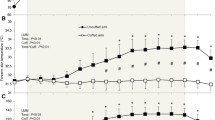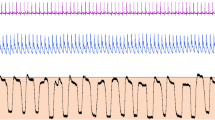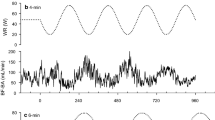Abstract
The effect of physical training on the cutaneous vascular response during transient exercise load is unclear. We determined the phase response and amplitude response of cutaneous vascular conductance (CVC) in the hand during sinusoidal exercise in endurance exercise-trained and untrained subjects. Subjects exercised on a cycle ergometer with a sinusoidal load for 32 min. The load variation ranged from 10% [23 (1) W in the trained group, 19 (1) W in the untrained group] to 60% [137 (4) W, 114 (6) W] of peak O2 uptake, and five different time periods (1, 2, 4, 8, and 16 min) were selected. Skin blood flow in the dorsal hand and palm were monitored by laser-Doppler flowmetry. CVC was evaluated from the ratio of blood flow to mean arterial pressure. During sinusoidal exercise, the amplitude of CVC was smaller in the dorsal hand than palm for shorter periods (1, 2, and 4 min) (P<0.05). The phase lag of CVC was smaller in the dorsal hand than palm for longer periods (8 and 16 min) (P<0.05). The amplitude response did not differ significantly between the two groups. The phase lag of CVC in the dorsal hand (P<0.05) and palm (P=0.06) was larger in the trained group than untrained group. These findings suggest that glabrous and nonglabrous skin vascular responses in the hand differ during transient exercise load, and physically trained subjects show a slower vascular response in the two skin areas to exercise stimulation than do untrained subjects.




Similar content being viewed by others
References
Abramson DI (1967) Vascular responses in skin. In: Circulation in the extremities. Academic Press, New York, pp 114–138
Bergersen TK, Eriksen M (1997) Local constriction of arteriovenous anastomoses in the cooled finger. Am J Physiol 273:R880–R886
Delp MD (1995) Effects of exercise training on endothelium-dependent peripheral vascular responsiveness. Med Sci Sports Exerc 27:1152–1157
Fadel PJ, Stromstad M, Hansen J, Sander M, Horn K, Ogoh S, Smith ML, Secher NH, Raven PB (2001) Arterial baroreflex control of sympathetic nerve activity during acute hypotension: effect of fitness. Am J Physiol 280:H2524–H2532
Fox RH, Hilton SM (1958) Bradykinin formation in human skin as a factor in heat vasodilation. J Physiol (Lond) 142:219–232
Greenfield ADM (1963) The circulation through the skin. In: Handbook of physiology. Circulation. Section 2, vol II, chapter 39. American Physiological Society, Washington DC, pp 1325–1351
Ho CW, Beard JL, Farrell PA, Minson CT, Kenney WL (1997) Age, fitness, and regional blood flow during exercise in the heat. J Appl Physiol 82:1126–1135
Ikegami H (2000) Sinusoidal work load. In: Sports medicine II. Health and exercise. Asakurashoten, Tokyo, pp 11–17 [in Japanese]
Johnson JM, Taylor WF, Shepherd AP, Park MK (1984) Laser-Doppler measurement of skin blood flow: comparison with plethysmography. J Appl Physiol 56:798–803
Johnson JM, Pérgola PE, Liao FK, Kellogg DL Jr, Crandall CG (1995) Skin of the dorsal aspect of human hands and fingers possesses an active vasodilator system. J Appl Physiol 78:948–954
Lindh, B, Haegerstrand A, Lundberg JM, Hökfelt T, Fahrenkrug J, Cuello AC, Graffi J, Massouli J (1988) Substance P-, VIP- and CGRP-like immunoreactivities coexist in a population of cholinergic postganglionic sympathetic nerves innervating sweat glands in the cat. Acta Physiol Scand 134:569–570
Lossius K, Eriksen M, Walloe L (1993) Fluctuations in blood flow to acral skin in humans: connection with heart rate and blood pressure variability. J Physiol (Lond) 460:641–655
Lundberg JM, Änggård A, Fahrenkrug J, Hökfelt T, Mutt V (1980) Vasoactive intestinal polypeptide in cholinergic neurons of exocrine glands: functional significance of coexisting transmitters for vasodilation and secretion. Proc Natl Acad Sci USA 77:1651–1655
Mack G, Shi X, Nose H, Tripathi A, Nadel ER (1987) Diminished baroreflex control of forearm vascular resistance in physically fit humans. J Appl Physiol 63:105–110
Roberts MF, Wenger CB, Stolwijk JAJ, Nadel ER (1977) Skin blood flow and sweating changes following exercise and heat acclimation. J Appl Physiol 43:133–137
Roddie IC (1983) Circulation to skin and adipose tissue. In: Handbook of physiology. The cardiovascular system. Peripheral circulation and organ blood flow. Section 2, vol III, part 1, chapter 10. American Physiological Society, Bethesda, Md., pp 285–317
Rowell LB (1977) Reflex control of the cutaneous vasculature. J Invest Dermatol 69:154–166
Seals DR, Chase PB (1989) Influence of physical training on heart rate variability and baroreflex circulatory control. J Appl Physiol 66:1886–1895
Tainio H, Vaalasti A, Rechardt L (1987) The distribution of substance P-, CGRP-, galanin- and ANP-like immunoreactive nerves in human sweat glands. Histochem J 19:375–380
Takeno Y, Kamijyo Y, Nose H (2001) Thermoregulatory and aerobic changes after endurance training in a hypobaric hypoxic and warm environment. J Appl Physiol 91:1520–1528
Tankersley CG, Smolander J, Kenney WL, Fortney SM (1991) Sweating and skin blood flow during exercise: effects of age and maximal oxygen uptake. J Appl Physiol 71:236–242
Thomas CM, Pierzga JM, Kenney WL (1999) Aerobic training and cutaneous vasodilation in young and older men. J Appl Physiol 86:1676–1686
Yamazaki F (2002) Vasomotor responses in glabrous and nonglabrous skin during sinusoidal exercise. Med Sci Sports Exerc 34:767–772
Yamazaki F, Fujii N, Sone R, Ikegami H (1994a) Mechanisms of potentiation in sweating induced by long-term physical training. Eur J Appl Physiol 69:228–232
Yamazaki F, Sone R, Ikegami H (1994b) Responses of sweating and body temperature to sinusoidal exercise. J Appl Physiol 76:2541–2545
Yamazaki F, Fujii N, Sone R, Ikegami H (1996) Responses of sweating and body temperature to sinusoidal exercise in physically trained men. J Appl Physiol 80:491–495
Acknowledgement
We thank all our subjects for their cheerful cooperation in completing the experiments required for this study.
Author information
Authors and Affiliations
Corresponding author
Rights and permissions
About this article
Cite this article
Yamazaki, F., Sone, R. Skin vascular response in the hand during sinusoidal exercise in physically trained subjects. Eur J Appl Physiol 90, 159–164 (2003). https://doi.org/10.1007/s00421-003-0864-9
Accepted:
Published:
Issue Date:
DOI: https://doi.org/10.1007/s00421-003-0864-9




